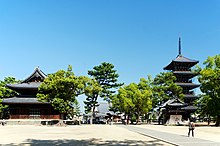Zentsū-ji
| Byōbuura Gogakusan Tanjō-in Zentsū-ji | |
|---|---|
 | |
| Religion | |
| Affiliation | Shingon Buddhism |
| Location | |
| Location | 3-1, Zentsūji-cho, Zentsūji, Kagawa |
| Country | Japan |
| Architecture | |
| Founder | Zentsū Saeki |
| Completed | 807 |

Pagoda
The Byōbuura Gogakusan Tanjō-in Zentsū-ji (屏風浦五岳山誕生院善通寺) is a temple of the Shingon sect in Zentsūji, Kagawa, Japan. It was established by Zentsū Saeki, the father of Kūkai, in 813. The East Academy (Tō-in) and the West Academy (Sai-in) are within Zentsu-ji precincts. The West Academy is Kūkai's birthplace.
Zentsū-ji is temple No. 75 in the Shikoku Pilgrimage. It is also one of the three temples on the tour that Kūkai visited, the others being and Muroto Misaki, as Kūkai mentioned them by name in his writings.[citation needed]
Building list[]
Tō-in[]
- Pagoda – It was rebuilt in 1884. Important Cultural Properties of Japan.
- Golden Hall – It was rebuilt in 1700. Important Cultural Properties of Japan.
- – It was rebuilt in 1673–1681. Registered Tangible Cultural Property.
- Bell tower – Registered Tangible Cultural Property.
- – Registered Tangible Cultural Property.
- Chūmon
Sai-in[]
- – It was rebuilt in 1831. Registered Tangible Cultural Property.
- Nio gate – It was rebuilt in 1889. Registered Tangible Cultural Property.
- – It was rebuilt in 1889. Registered Tangible Cultural Property.
- Henjōkaku
Temple treasure[]
- Gilt bronze finial of a pilgrim's staff – National Treasure
- Preface to the Lotus Sutra decorated with Buddhas – National Treasure
- Jizō Bosatsu ryūzō – Important Cultural Property
- Kichijōten ryūzō – Important Cultural Property
See also[]
- National Treasures of Japan
- List of National Treasures of Japan (writings)
- List of National Treasures of Japan (crafts: others)
Gallery[]

Golden Hall (Hondō)

Nio Gate and Kairō

Goeidō

Henjōkaku
External links[]
| Wikimedia Commons has media related to Zentsu-ji. |
- About ZENTSUJI
- (in English) Zentsuji temple - Kagawa Prefecture - Japan travel guide-title
- (in English) Fox and Amy in Japan Zentsuji Temple
- (in English) Zentsuji Temple Kotohira 2 Shikoku Japan Travel Guide and Information att.JAPAN
- (in English) Documentary movie about the 88 Temple Pilgrimage
- Guide to start the Shikoku 88 temples pilgrimage (french-english)
- (in English) Echoes of Incense - A Pilgrimage in Japan by Don Weiss
- (in English) A Shikoku Pilgrimage by Jasbir Sandhu
Coordinates: 34°13′30.4″N 133°46′26.9″E / 34.225111°N 133.774139°E
Categories:
- 9th-century establishments in Japan
- National Treasures of Japan
- Important Cultural Properties of Japan
- Shingon Buddhism
- Pagodas in Japan
- Buddhist temples in Kagawa Prefecture
- Religious buildings and structures completed in 807
- Japanese religious building and structure stubs
- Buddhist temple stubs




